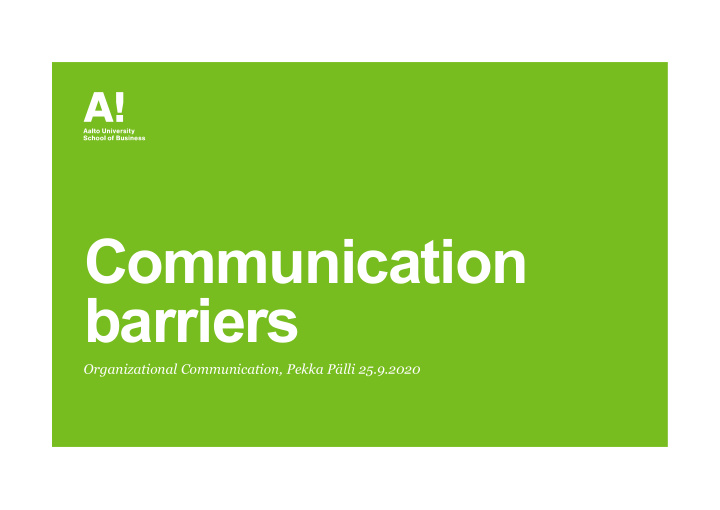



Communication barriers Organizational Communication, Pekka Pälli 25.9.2020
Agenda & objective • Mapping the common barrier types • Getting insights on how to overcome (at least understand) communication barriers 24.9.2020 2
Flying shepherd girl catching frisbee… 24.9.2020 5
The sources of barriers– according to the transfer model 24.9.2020 6
Where and why barriers to communication lie? • Coding and decoding process (and the medium/channel (transmission) • Perceptions and predispositions • Context • Language • Culture 7
Perceptions and predispositions • Stereotyping (seeing the other person through over-generalization, as a representative of a category) • Assumptions about other person’s intentions and values • Assuming that the audience has the knowledge or capacity to understand the message • Perceived status, e.g. if we think that the person we’re communicating with is of much higher or lower status than we are 8
Context • Physical context/environment causing physical barriers : • Interference – distractions, noise, problems with technology Discomfort – physical circumstances which affect concentration • such as being too hot or too cold, feeling ill, etc. • Emotional context causing emotional barriers • E.g. a person feeling angry, can affect the atmosphere in a meeting and distort messages. 9
Language • Language barrier generally: inability to share ideas in common language • More specific language barriers: Jargon: technical terminology and idioms used by specific communities of • practice (many professions rely heavily on jargon and have their own ‘language’ that is impenetrable to outsiders). Not knowing or being familiar with jargon or “lingo” of the field may hinder participation or appropriate contributions • Acronyms and abbreviations: although these can form an useful shorthand, they exclude receivers who are not familiar with their meaning • Semantics and pragmatics that are (often) related to culture 24.9.2020 10
Culture • Noticeable cultural differences in the ways that people Greet each other: for example, in some cultures kiss is “a must” while • others settle for a briefest of handshake • Use and interpret gestures • Use and interpret speech acts (questions, requests, commands, apologies etc.) Use personal space (proxemics): for example, in general northern • Europeans are less comfortable with touching than e.g. southern Europeans, or people from the Middle East. Interact and are expected to interact verbally: for example, Americans may • value direct verbal interaction and ‘straight speaking’ whereas the Japanese value spiral logic and indirect verbal interaction. 11
Culture, cont’d Women and men socialized differently (Deborah Tannen, author of e.g. ”You Just Don’t Understand. Men and women in conversation”. See too Tannen (1995) Power of Talk, in Harvard Business Review ) This results in ”cultural differences” in linguistic styles, such as: • Men sensitive to power dynamics, so they speak in ways that position them as one-up position by others, whereas women tend to react to the rapport dynamics more strongly (thus saving face for others) • Confidence and boasting: psychological research has shown that women are more likely to downplay their certainty, whereas men are more likely to minimize their doubts • Asking questions: men try to avoid asking questions as they are attentive to the fact that asking questions may put them in a one-down positions • Women use more compliments, not always meaning them literally (men take them more literally). Same is with apologies. • Indirectness: men likely to be more indirect when it comes to e.g. admitting a fault, women more indirect when it comes to telling others what to do 12
How to overcome the barriers to communication – or reduce the risks of miscommunication? 13
Some most common pieces of advice for managerial communication • Be clear in your own mind about what you want to communicate. • Select the right medium and use it appropriately. • Step into the receiver’s shoes and anticipate the impact of your communication. • Use feedback to encourage two-way communication and check understanding. • If you want to influence, communicate directly, preferably face-to-face so that you can use non-verbal signals. • Limit the number of links in the communication chain.
Team leader Dept. Head 1 Team leader Team leader Dept. Head 2 Team leader All 300 employees CEO CCO Team leader Dept. Head 3 Team leader Team leader Dept. Head 4 Team leader 15
Exercise on overcoming communication barriers Think about a conversation or any communicational event you have been involved recently. Try to come up with an example incident – an interactional situation between individual persons or a group of people – where there was a barrier in communication. You should have been the one “sending the message”. Reflect on the communication and identify the barriers that may have led to distortion. And, what could have been done to overcome the barrier(s)? Example table Communication I was involved in Communication Barriers and why the barrier channel occurred? Informing team about new efficiency Presentation to group of - Technology/medium (voice quality in Zoom was poor) targets that will be rolled out over the six team members - Assumption that all team next three months members were familiar with old efficiency targets (turned out to be a wrong assumption) Etc. 16
Recommend
More recommend